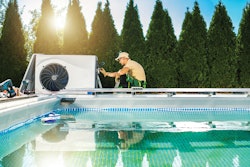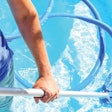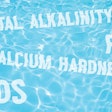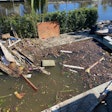
As the industry's sophistication in understanding pool water chemistry has grown in the last few decades, so has popular acceptance of The Langelier Saturation Index (LSI) as a tool for maintaining balance.
There remains some confusion about the Index both within the pool water testing community (as in those who may use it in balancing water, but don't really know much more than that) and in the larger pool and spa community (as in those who are vaguely aware it's got something to do with pool chemistry, but often get LSI confused with CSI, a popular television show).
In simplest terms, LSI is an equation into which you can plug your pool water test results that will spit out a single number that tells you whether your water is aggressive or scale forming. Aggressive, as in desiring to suck calcium from plaster. Scale forming, as in tending to deposit a layer of calcium scale on pool walls, heat exchangers, pipes and other places it's not welcome.
Calculating LSI is part of balancing pool water — the part that tells you if your water is aggressive or scale forming. But balancing to LSI neutrality is not a full examination of pool water. Or put another way, when you've balanced water to LSI, you're not done. There are other factors to consider and perhaps adjust to make sure the water doesn't grow algae or irritate bathers.
In the words of Alicia Stephens, director of training and education for the BioLab Pro Dealer Division, LSI is just a snapshot of your pool telling you something about the overall nature of your pool water, but it doesn't give you details.
"When I'm teaching a class to people that may not be familiar with it," she says, "I always describe LSI this way: Say you pull up to a drive-up window and read their health score posted in the window. And it's like 93 out of 100. Which is satisfactory but not perfect. And you're like, 'Okay, 93, they were inspected, and I assume that most things were fine.'
"You have no idea what was wrong, why they didn't get 100. But you're like, 'Okay, that's fine. I'm going to eat the food.'
"Now, if you see a health score of 72, you still have no idea what's wrong, but you know that's… not so good. It could have been cockroaches in the kitchen, it could have been meat stored at the wrong temperature. You have no idea. You just know it's not good.
"And that's kind of the way LSI works. It just gives you a 'not so good' answer or a 'you're fine' answer, but it doesn't really tell you exactly what's going on."
In the same way a restaurant might have a hygiene problem, but can still achieve a satisfactory health score by doing a great job on all other facets, the LSI can be adjusted to achieve neutral water even if a parameter is out of whack. For example, pool water might have a high pH value of 8.2, but the LSI equation can still be balanced to 0.0 by adjusting other factors, maybe low total alkalinity and calcium.
And that means the water truly isn't corrosive or scale-forming. It's balanced to the LSI, but there's definitely a problem with a pH of 8.2. That's going to make chlorine weak and ineffective, which will prevent it from killing pathogens and algae, leading to big problems in the pool. So techs look beyond LSI to completely understand a pool's chemistry.
 Dr. Wilfred Langelier, inventor of the Langelier Saturation Index, pictured here in 1912.
Dr. Wilfred Langelier, inventor of the Langelier Saturation Index, pictured here in 1912.
JUDGMENT CALLS
As a practical matter, there are only three factors that can be adjusted by a poolside tech to balance to LSI — pH, alkalinity, and calcium hardness (temperature and TDS cannot be altered in a short visit). So the pool tech can adjust those three while keeping in mind if they get too far out of whack to satisfy LSI, they will cause other problems. The tech is really engineering the water at this point, but like any engineer, must keep in mind the projected service life.
Stephens describes a challenging example: "Someone might say, for someone closing a pool for winter, 'Raise your calcium up super high because cold water is aggressive, and raising up your calcium will balance LSI and keep your water from being aggressive. At the same time, in order to balance LSI, you must drop your pH.
"So you lower pH to say, 6.8, to balance the LSI. But just because LSI is balanced doesn't mean you don't get the impact of what happens with low pH. And once you roll back into warm temperatures, well, now LSI is skewed to the scale building side because of all the calcium you put in and can't take out. Now you've got to keep your pH level low to get anywhere close to balancing the LSI. So you've created a problem that you didn't have in cold water.
"With your pH at 6.8, your chlorine becomes so active that it burns up immediately. You use it so quickly you can't keep your residual. So your LSI is balanced, but you're not sanitizing your pool because you can't keep chlorine in the water. And now things start to grow.
"So that's why I call it kind of a dual approach. We do use the LSI, and we're very cognizant of it, and we do balance to it, but we also don't let our balance parameters like pH go outside of accepted limits."
RUNNING IN THE BACKGROUND
While plenty of pool care pros think in terms of LSI every day, there are many others in the industry who have been calculating LSI for years and don't even realize it. It's embedded into water balancing software and apps, whether they are being pulled up on a smart phone poolside, or on the pc at the water test station at the dealership.
"Those all run LSI in the background, in the algorithms of the software," Stephens says. "In our [BioGuard's Alex Water Testing] software, we don't print out that LSI number, but we are balancing to LSI."
Which, ultimately, is much to the benefit of the residential pool customer. In the 88 years since Cal Berkeley professor Wilfred Langelier came up with the LSI equation, its gradual acceptance in the industry represents a step forward in the care of swimming pools, providing pros the ability to determine whether pool water will cause corrosion or deposit scale.









































